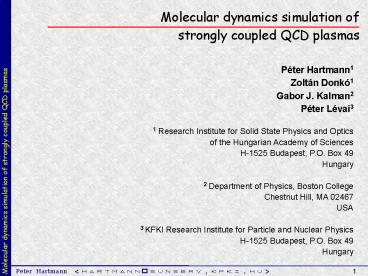Molecular dynamics simulation of strongly coupled QCD plasmas - PowerPoint PPT Presentation
1 / 14
Title:
Molecular dynamics simulation of strongly coupled QCD plasmas
Description:
Molecular dynamics simulation of strongly coupled QCD plasmas ... Chestnut Hill, MA 02467. USA. 3 KFKI Research Institute for Particle and Nuclear Physics ... – PowerPoint PPT presentation
Number of Views:33
Avg rating:3.0/5.0
Title: Molecular dynamics simulation of strongly coupled QCD plasmas
1
Molecular dynamics simulation of strongly
coupled QCD plasmas
Péter Hartmann1 Zoltán Donkó1 Gabor J.
Kalman2 Péter Lévai3 1 Research Institute for
Solid State Physics and Optics of the Hungarian
Academy of Sciences H-1525 Budapest, P.O. Box
49 Hungary 2 Department of Physics, Boston
College Chestnut Hill, MA 02467 USA 3 KFKI
Research Institute for Particle and Nuclear
Physics H-1525 Budapest, P.O. Box 49 Hungary
2
Molecular dynamics simulation of strongly
coupled QCD plasmas
Outline
- Introduction
- strongly interacting quark-gluon plasma
- classical, strongly coupled, abelian plasmas
- The molecular dynamics simulation
- potential model for QCD forces
- color rotation (random gluon interaction)
- Results of the simulation
- resonant plasma heating
- clusterization, correlation
- Results of the model
- G plasma coupling parameter
3
Introduction The quark-gluon plasma
Lattice QCD (Fodor, Katz JHEP 040 (2004) 050)
- Latest results
- Cross-over phase transition
- Strongly correlated (liquid-like) system
- Massive quasi particles
sQGP
Similar properties to classical, strongly
interactingabelian plasma (with large G)
The aim of this work is to apply classical
strongly coupled plasma physics methods to
describe sQGP properties.
4
Introduction classical strongly coupled plasmas
The simplest system classical one-component
plasma (OCP). OCP charged heavy particles
immersed into a homogeneous neutralizing
background.
interaction (Coulomb) potential
system parameters
universal parameters
- investigated properties
- structure (pair correlation function, static
structure function) - thermodynamics (internal energy,
compressibility, equation of state, phase
diagram) - transport phenomena (thermal conductivity, shear
viscosity, diffusion) - collective dynamics (density and current
fluctuations, dispersion relations, instabilities)
5
Our model
Our sQGP model is rooted on the classical OCP
model. The links are
- The numerical simulation is based on the
classical molecular dynamics scheme - calculating the forces acting on each particle
due to all other particles - integrating the equation of motion for all
particles in each time-step - using periodic boundary conditions to handle
long range forces - implementing color rotation due to random
gluonic interaction
6
potential model for QCD interaction
color dependent interaction potential between
quark i and j
possible two-quark states ( R, G and B are the
single-quark color states)
color factor
7
The interaction matrix
Consequences
- equally colored quarks repulse each other
- different colors may repulse or attract each
other
An example interaction matrix of a 9-quark
system (excluding self-interaction and double
counting)
- quark-gluon interaction
- redistribution of elements D in the interaction
matrix (with a characteristic time tD) - color rotation exchange of colors of some
quark pairs (tC)
8
MD results
- In the following we present preliminary molecular
dynamics results for quark plasma with physical
parameters - kinetic temperature, T0 200 MeV
- particle density, n 10 quarks / fm3
- interaction strength, aS 1
- quark mass, m 300 MeV
- and technical parameters
- number of particles, N 300
- starting positions random
- initialization time, ti 1061 dt
- measure time, tm 2x105 dt
- time-step, dt 5x10-5 fm
- cutoff distance, rcut 0.1 fm
- measured parameters are
- kinetic temperature, T(t)
- pair correlation function, g(r)
9
Resonant plasma heating
Increase of system temperature appears due to the
redistribution of the interparticle forces
(reassignment of D terms)
10
Clusterization
The structural evolution of the system is
determined by the time dependence of the
interaction ( color rotation)
11
Correlations
More detailed insight into structural properties
gives the pair-correlation function g(r)
Using g(r) data solid, liquid and gas structural
phases can be identified.
12
The plasma coupling parameter - G
What is the value of G for the quark plasma?
13
Summary
- We have presented a possible application of the
methodology developed for strongly coupled EM
plasmas for the numerical investigation of sQGP. - A quasi-classical implementation of the QCD
interaction has been developed. - Simulations were carried out for quark plasma
near the critical temperature - energy transfer from the background filed shows
a resonance like behavior - structural studies show the tendency of cluster
formation - pair correlation functions show the presence of
short-range correlations - the plasma coupling parameter G is in the order
of unity
To do
Lots of exciting research ?
Discussions with Miklos Gyulassy and the support
by grants OTKA T-48389, MTA-OTKA-90/46140,
NSF-PHYS-0206695 and DOE-DE-FG02-03ER5471 are
gratefully acknowledged.
14
- Thank you
- for your attention!































